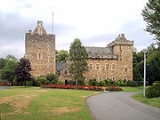
Dean Castle
Encyclopedia
Dean Castle is situated in the Dean Castle Country Park in Kilmarnock
, East Ayrshire, Scotland
. It was the stronghold for the Boyd Family
, who were lords of Kilmarnock for over 400 years.
The Castle takes its name from ‘The Dean’ or wooded valley, a common place name in Scotland. However, until about 1700 it was called Kilmarnock Castle. Owned originally by the Boyd family, it has strong historical connections with many people and events famous in Scottish history. Robert the Bruce who gave the Boyds these lands; James III of Scotland
whose sister married a Boyd; the Covenanters, some of whom were imprisoned here; Bonnie Prince Charlie, whose rebellion was joined by the 4th Earl of Kilmarnock and Robert Burns
who was encouraged to publish his poetry by the Earl of Glencairn
who owned the Castle at that time.
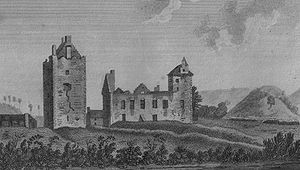
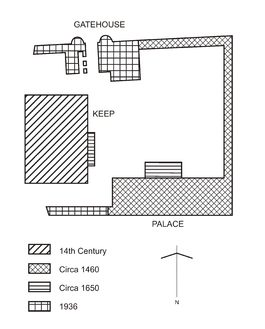 The Boyd Family came into possession of the grounds of Dean Castle in 1316, when Sir Robert Boyd was rewarded the lands of Kilmarnock and West Kilbride by King Robert I for his services at the Battle of Bannockburn
The Boyd Family came into possession of the grounds of Dean Castle in 1316, when Sir Robert Boyd was rewarded the lands of Kilmarnock and West Kilbride by King Robert I for his services at the Battle of Bannockburn
.
. It was built mainly for defence, the walls are 2-3 metres thick, it has few windows, and the original entrance is high above ground level. There are no arrowslits in the walls of Dean Castle something which is very rare for a Scottish castle of this time period, all of the shooting was done from the battlements at the top.
when he was appointed by James II
c.1454. In 1735 an accidental fire started in the kitchen of the palace, this fire then spread onto the thatched roof where it then spread onto the roof of the keep. The Castle was a complete ruin after this and had almost two centuries of neglect, although some of the buildings always remained in use. The resident of the castle William Boyd, 4th Earl of Kilmarnock
had financial problems and could not afford to repair the castle.
inherited the castle he began its restoration. He completed the keep in 1908 and completed the restoration of the palace in 1946.
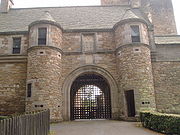
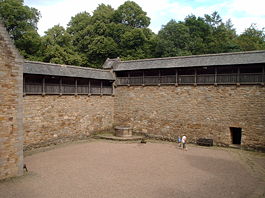 The present Gatehouse was entirely built in 1935-6. It was never present in the original castle. However it is carefully copied from real sixteenth-century buildings, including details like the windows with half-wooden shutters and half-leaded glass. The overall design and decorative but usable gun loops are copied from the gatehouse built at Tolquhon Castle
The present Gatehouse was entirely built in 1935-6. It was never present in the original castle. However it is carefully copied from real sixteenth-century buildings, including details like the windows with half-wooden shutters and half-leaded glass. The overall design and decorative but usable gun loops are copied from the gatehouse built at Tolquhon Castle
, Aberdeenshire built in the 1580s. The wooden walkway around the wall guarding the palace was added in the restoration.
. When the keep was originally built both the kitchen and dungeon could only be accessed from the first floor via a ladder, there were no doors leading outside.
s would play instruments and act for the Lord and Lady sitting below. Off the minstrel's gallery is the minstrels changing room, were the travelling players would change into their bright costumes. This room would also have been used by the minstrels to sleep in, the reason for them having their own private quarters was that it was feared that many of them would have been carrying disease. Therefore they slept here to stop them passing any ailments on to other guests. The guard room also sits on the first floor. The guard room has the only access to the dungeon in the castle, a small hole in the floor where prisoners were thrown in. A guard would always be present in this room to both guard the dungeon but also the only entrance to the castle, a small door above ground level, which is next to the guard room.
a large room, used as the private chambers for the Lord and Lady. The Solar could be split into two using a large curtain, one half for Ladies and the other for men. There are two fireplaces in the Solar one on each side for either sex. The Solar also houses a small private chapel
. This was used by the Lord and Lady of the castle and a priest who stayed in the castle would deliver mass
to the family. A small ladies bowyer is present on this floor also.
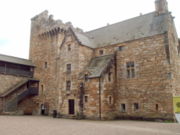
Defence was not ignored in the construction of the Palace. The tower has projecting battlements and Lord Boyd’s private apartments were inside. This tower was known as the Laigh or Low Tower, although high it is lower than the Keep. Also the courtyard was protected by a high wall which was called the Barmkin. This protected the various other buildings housed in the courtyard, such as stables, stores and blacksmiths.
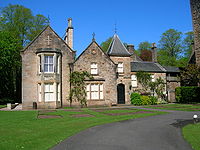 In 1975 the 9th Lord Howard de Walden gifted the castle, estate, his father’s collections of arms and armour, and his grandfather’s collection of musical instruments to the people of Kilmarnock
In 1975 the 9th Lord Howard de Walden gifted the castle, estate, his father’s collections of arms and armour, and his grandfather’s collection of musical instruments to the people of Kilmarnock
.
The collections of arms and armour are on display in the Great Hall of the keep and the musical instruments are on display in the Solar of the keep. The banqueting hall displays many items owned by East Ayrshire council including Kilmarnock Edition of Robert Burns poetry and many works of art.
The private chamber of the Earls of Kilmarnock has a complete model of the castle. Legend has it that after the 4th Earl of Kilmarnock was beheaded for treason in London on 18 August 1746 his head was carried back to Dean castle and was stored in a large chest which is still present in the Laigh Tower.
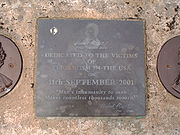 The story of the 4th Earl’s head being kept in the castle has attracted many ghost hunters who have studied the castle and believe there is a presence in the palace.
The story of the 4th Earl’s head being kept in the castle has attracted many ghost hunters who have studied the castle and believe there is a presence in the palace.
A large bust of William Wallace
is on display on the ground floor of the palace.
Dean castle and Country Park is maintained by East Ayrshire Council and is free to access. There are daily tours of the castle which are also free.
The Robert Burns World Federation recently unveiled a plaque to the memory of those who lost their lives in the terrorist attacks on 11 September 2001.
The plaque reads:
Dedicated to the victims of terrorism in the USA on 11 September 2001
"Man’s Inhumanity to man
Makes countless thousands mourn!"
Robert Burns (1759 – 1796)
Kilmarnock
Kilmarnock is a large burgh in East Ayrshire, Scotland, with a population of 44,734. It is the second largest town in Ayrshire. The River Irvine runs through its eastern section, and the Kilmarnock Water passes through it, giving rise to the name 'Bank Street'...
, East Ayrshire, Scotland
Scotland
Scotland is a country that is part of the United Kingdom. Occupying the northern third of the island of Great Britain, it shares a border with England to the south and is bounded by the North Sea to the east, the Atlantic Ocean to the north and west, and the North Channel and Irish Sea to the...
. It was the stronghold for the Boyd Family
Clan Boyd
Clan Boyd is a Lowland Scottish clan from Kilmarnock in Ayrshire, Scotland.-Origins of the clan:The origin of the Boyd family name may be either from the Gaelic language or from the Normans, but in both cases translates as 'fair', 'blonde', 'yellow or fair,' etcetera...
, who were lords of Kilmarnock for over 400 years.
The Castle takes its name from ‘The Dean’ or wooded valley, a common place name in Scotland. However, until about 1700 it was called Kilmarnock Castle. Owned originally by the Boyd family, it has strong historical connections with many people and events famous in Scottish history. Robert the Bruce who gave the Boyds these lands; James III of Scotland
James III of Scotland
James III was King of Scots from 1460 to 1488. James was an unpopular and ineffective monarch owing to an unwillingness to administer justice fairly, a policy of pursuing alliance with the Kingdom of England, and a disastrous relationship with nearly all his extended family.His reputation as the...
whose sister married a Boyd; the Covenanters, some of whom were imprisoned here; Bonnie Prince Charlie, whose rebellion was joined by the 4th Earl of Kilmarnock and Robert Burns
Robert Burns
Robert Burns was a Scottish poet and a lyricist. He is widely regarded as the national poet of Scotland, and is celebrated worldwide...
who was encouraged to publish his poetry by the Earl of Glencairn
James Cunningham, 13th Earl of Glencairn
James Cunningham, 14th Earl of Glencairn was a Scottish nobleman, and a representative peer from 1780.A Captain in the West Fencible Regiment from 1778, he was also a great supporter and friend of Robbie Burns...
who owned the Castle at that time.
History


Battle of Bannockburn
The Battle of Bannockburn was a significant Scottish victory in the Wars of Scottish Independence...
.
Keep
The Keep was built around 1350 by Sir Robert Boyd’s son Sir Thomas BoydSir Thomas Boyd
Sir Thomas Boyd of Kilmarnock was a 14th century Scottish landowner and lord of Kilmarnock in Ayrshire. He was the son of Sir Robert Boyd, who fought at the Battle of Bannockburn. In 1346, he was taken prisoner at the battle of Neville's Cross. He is known for building the earliest parts of Dean...
. It was built mainly for defence, the walls are 2-3 metres thick, it has few windows, and the original entrance is high above ground level. There are no arrowslits in the walls of Dean Castle something which is very rare for a Scottish castle of this time period, all of the shooting was done from the battlements at the top.
Palace
The palace was built in the 1460s by Robert Boyd, 1st Lord BoydRobert Boyd, 1st Lord Boyd
Robert Boyd, 1st Lord Boyd Lord Boyd, was a Scottish statesman.-Biography:Robert Boyd was knighted, and was created a Peer of Parliament by James II of Scotland at some date between 1451 and 18 July 1454 . In 1460 he was one of the Regents during the minority of James III...
when he was appointed by James II
James II of Scotland
James II reigned as King of Scots from 1437 to his death.He was the son of James I, King of Scots, and Joan Beaufort...
c.1454. In 1735 an accidental fire started in the kitchen of the palace, this fire then spread onto the thatched roof where it then spread onto the roof of the keep. The Castle was a complete ruin after this and had almost two centuries of neglect, although some of the buildings always remained in use. The resident of the castle William Boyd, 4th Earl of Kilmarnock
William Boyd, 4th Earl of Kilmarnock
William Boyd , 4th Earl of Kilmarnock, was a Scottish nobleman.William Boyd was educated at Glasgow. Like his father in the rebellion of 1715, William initially supported the Government side, but in the rebellion of 1745, owing either to a personal affront or to the influence of his wife or to his...
had financial problems and could not afford to repair the castle.
Rebuilding
The castle was sold by James Boyd in 1746 and the estate changed hands many times. When the 8th Lord Howard de WaldenThomas Scott-Ellis, 8th Baron Howard de Walden
Thomas Evelyn Scott-Ellis, 8th Baron Howard de Walden, 4th Baron Seaford , was a British peer, landowner, writer and patron of the arts. He was also a motorboat racer who competed in the 1908 Summer Olympics.-Biography:...
inherited the castle he began its restoration. He completed the keep in 1908 and completed the restoration of the palace in 1946.


Tolquhon Castle
Tolquhon Castle is located in Aberdeenshire, about 20 miles northwest of Aberdeen. The current castle was built by William Forbes from 1584-1589 to replace an earlier towerhouse known as Preston's Tower, which is still partly intact, forming the left-hand tower when viewed from in front of the...
, Aberdeenshire built in the 1580s. The wooden walkway around the wall guarding the palace was added in the restoration.
Ground floor
The ground floor housed the cellar which housed the original kitchen for the Great hall above. Also on the ground floor was the bottleneck dungeonDungeon
A dungeon is a room or cell in which prisoners are held, especially underground. Dungeons are generally associated with medieval castles, though their association with torture probably belongs more to the Renaissance period...
. When the keep was originally built both the kitchen and dungeon could only be accessed from the first floor via a ladder, there were no doors leading outside.
First floor
The first floor is were the Great Hall with its large vaulted ceiling is situated. The Great Hall was mainly used for grand banquets and entertainment for the lord and his guests. Guests staying at the castle would have also slept on the floor of the Great Hall. The Hall also served as a court as the lord would act as a judge passing verdicts and sentences for crimes committed in the surrounding area. The first floor also has a minstrel's gallery were a group of travelling minstrelMinstrel
A minstrel was a medieval European bard who performed songs whose lyrics told stories of distant places or of existing or imaginary historical events. Although minstrels created their own tales, often they would memorize and embellish the works of others. Frequently they were retained by royalty...
s would play instruments and act for the Lord and Lady sitting below. Off the minstrel's gallery is the minstrels changing room, were the travelling players would change into their bright costumes. This room would also have been used by the minstrels to sleep in, the reason for them having their own private quarters was that it was feared that many of them would have been carrying disease. Therefore they slept here to stop them passing any ailments on to other guests. The guard room also sits on the first floor. The guard room has the only access to the dungeon in the castle, a small hole in the floor where prisoners were thrown in. A guard would always be present in this room to both guard the dungeon but also the only entrance to the castle, a small door above ground level, which is next to the guard room.
Second floor
The second floor houses the SolarSolar (room)
The solar was a room in many English and French medieval manor houses, great houses and castles, generally situated on an upper storey, designed as the family's private living and sleeping quarters...
a large room, used as the private chambers for the Lord and Lady. The Solar could be split into two using a large curtain, one half for Ladies and the other for men. There are two fireplaces in the Solar one on each side for either sex. The Solar also houses a small private chapel
Chapel
A chapel is a building used by Christians as a place of fellowship and worship. It may be part of a larger structure or complex, such as a church, college, hospital, palace, prison or funeral home, located on board a military or commercial ship, or it may be an entirely free-standing building,...
. This was used by the Lord and Lady of the castle and a priest who stayed in the castle would deliver mass
Mass (liturgy)
"Mass" is one of the names by which the sacrament of the Eucharist is called in the Roman Catholic Church: others are "Eucharist", the "Lord's Supper", the "Breaking of Bread", the "Eucharistic assembly ", the "memorial of the Lord's Passion and Resurrection", the "Holy Sacrifice", the "Holy and...
to the family. A small ladies bowyer is present on this floor also.
Third floor
This is on top of the keep were archers could defend the castle if attacked. On the third floor there is also a small set of apartments for soldiers to stay in.
Palace
The palace was mainly designed for comfort. On the ground floor of the palace was the kitchen with a large fireplace and oven. The first floor has the Banqueting Hall and above on the second hall had bedrooms for the family. The original stair case leading up to the first floor was a wooden one which ran up the outside of the building, however due to the wet climate a stone stair case was later added inside the palace.Defence was not ignored in the construction of the Palace. The tower has projecting battlements and Lord Boyd’s private apartments were inside. This tower was known as the Laigh or Low Tower, although high it is lower than the Keep. Also the courtyard was protected by a high wall which was called the Barmkin. This protected the various other buildings housed in the courtyard, such as stables, stores and blacksmiths.
The Castle today

Kilmarnock
Kilmarnock is a large burgh in East Ayrshire, Scotland, with a population of 44,734. It is the second largest town in Ayrshire. The River Irvine runs through its eastern section, and the Kilmarnock Water passes through it, giving rise to the name 'Bank Street'...
.
The collections of arms and armour are on display in the Great Hall of the keep and the musical instruments are on display in the Solar of the keep. The banqueting hall displays many items owned by East Ayrshire council including Kilmarnock Edition of Robert Burns poetry and many works of art.
The private chamber of the Earls of Kilmarnock has a complete model of the castle. Legend has it that after the 4th Earl of Kilmarnock was beheaded for treason in London on 18 August 1746 his head was carried back to Dean castle and was stored in a large chest which is still present in the Laigh Tower.

A large bust of William Wallace
William Wallace
Sir William Wallace was a Scottish knight and landowner who became one of the main leaders during the Wars of Scottish Independence....
is on display on the ground floor of the palace.
Dean castle and Country Park is maintained by East Ayrshire Council and is free to access. There are daily tours of the castle which are also free.
The Robert Burns World Federation recently unveiled a plaque to the memory of those who lost their lives in the terrorist attacks on 11 September 2001.
The plaque reads:
Dedicated to the victims of terrorism in the USA on 11 September 2001
"Man’s Inhumanity to man
Makes countless thousands mourn!"
Robert Burns (1759 – 1796)

